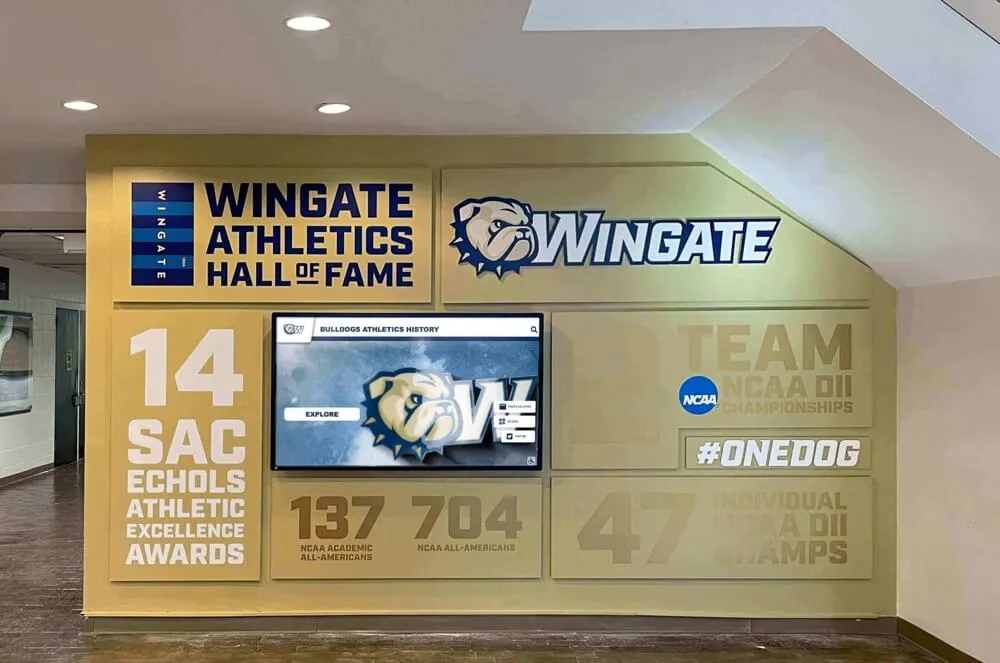Key Takeaways
Discover proven strategies for creating impactful alumni recognition programs that honor excellence, inspire students, and strengthen institutional bonds. From selection criteria to digital displays, learn everything you need to know.
Understanding the Strategic Value of Alumni Recognition
Alumni recognition programs deliver measurable benefits that extend far beyond ceremonial functions. Strategic recognition initiatives create ripple effects throughout your entire institutional ecosystem, strengthening culture, enhancing reputation, and generating tangible returns on investment.
Why Alumni Recognition Matters More Than Ever
In an increasingly competitive educational landscape, effective alumni recognition programs provide distinct advantages:
Inspiring Current Students: Recognition programs make success tangible and achievable for current students. When they see alumni who walked the same hallways now celebrated for significant accomplishments, excellence transforms from abstract concept to concrete possibility. Students discover that achievement takes many forms and that their institution produces graduates making meaningful contributions across diverse fields and industries.
Strengthening Alumni Engagement: Being recognized matters profoundly. According to research on alumni engagement, recognition serves as a powerful motivator for continued participation. Alumni who feel honored by their alma mater maintain stronger emotional connections, participate more actively in institutional life, volunteer more frequently, and contribute more generously to fundraising campaigns. Recognition creates visible acknowledgment that reinforces bonds and encourages ongoing involvement throughout alumni lifetimes.
Enhancing Institutional Reputation: Showcasing distinguished graduates builds community pride while enhancing institutional reputation with prospective students, their families, donors, and broader communities. Recognition programs demonstrate educational quality and the caliber of individuals institutions produce, creating positive impressions that support recruitment, fundraising, and community relationships.
Building Community Connections: Recognition programs unite diverse constituencies around shared pride in institutional excellence. They create common ground between students, faculty, staff, alumni, and community members while reinforcing institutional values and culture.
Preserving Institutional Legacy: Alumni recognition documents institutional history, preserving stories and achievements that might otherwise fade as time passes. These programs create continuity between past, present, and future while honoring those who paved the way for current success.
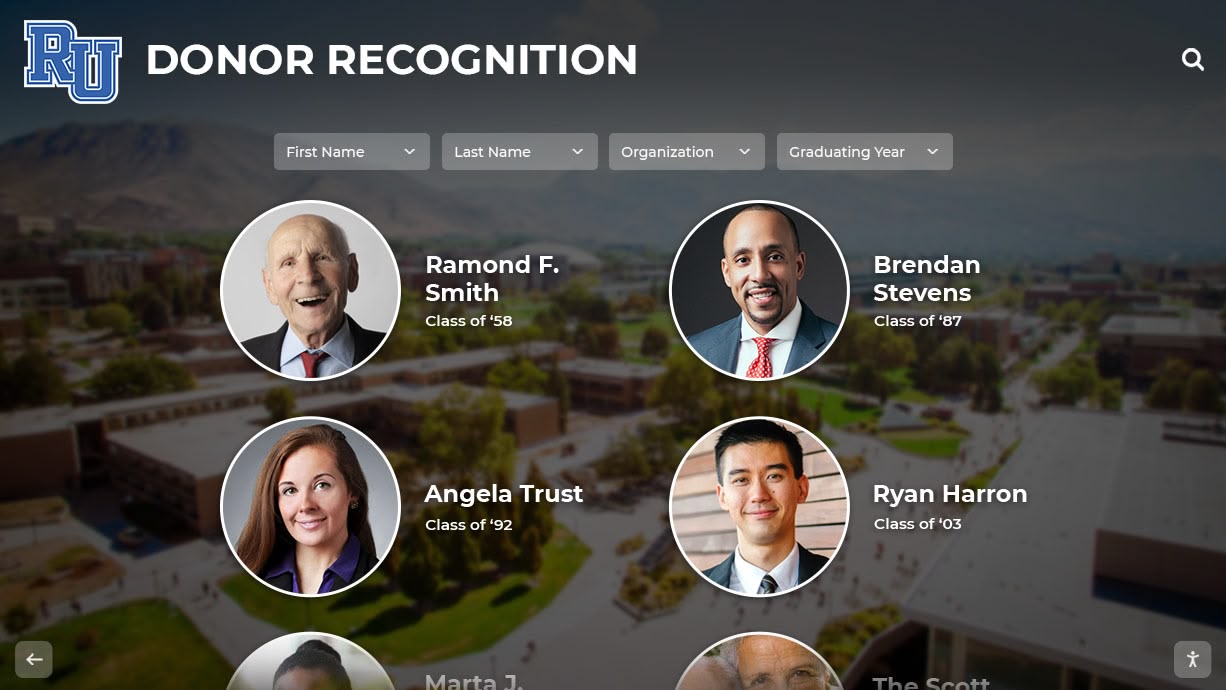
The Evolution of Recognition Programs in 2025
Modern alumni recognition programs have evolved significantly beyond simple annual award ceremonies and engraved plaques. Contemporary best practices reflect changing alumni expectations, technological capabilities, and deeper understanding of what drives meaningful engagement.
From Static to Dynamic Recognition: Traditional programs often featured limited annual induction ceremonies with physical plaques as primary recognition vehicles. While these elements remain valuable, leading programs now incorporate year-round recognition activities, digital storytelling platforms, social media spotlights, and interactive displays that keep recognition visible and engaging throughout the year.
From Limited to Inclusive Recognition: Historical programs often focused narrowly on traditional achievement categories like professional success or major donations. Progressive 2025 programs embrace broader definitions of distinction, recognizing diverse contributions including community service, creative accomplishments, entrepreneurship, humanitarian work, athletic achievement, academic excellence, and volunteer leadership. This inclusive approach ensures recognition programs reflect the full spectrum of ways alumni make meaningful impacts.
From One-Way to Interactive Recognition: Where recognition was once purely institutional—schools telling alumni they’re recognized—modern programs incorporate two-way engagement. Digital platforms enable alumni to share their stories, update their profiles, connect with each other, and engage with current students. This interactive dimension transforms recognition from static acknowledgment into ongoing relationship-building.
From Physical to Hybrid Recognition: While physical recognition displays remain important, leading programs now integrate digital components that dramatically expand capabilities. Solutions like digital recognition displays enable institutions to tell richer stories, reach broader audiences, and maintain recognition systems more efficiently than traditional approaches alone.
Essential Elements of Effective Alumni Recognition Programs
Successful alumni recognition programs share common characteristics that drive impact and sustainability regardless of institutional size or resources.
Clear Recognition Criteria and Selection Processes
Transparent, well-defined criteria ensure program credibility while facilitating fair evaluation of nominees:
🎓 Achievement-Based Criteria
Professional accomplishment, academic contribution, entrepreneurial success, leadership positions, field innovations, or peer recognition demonstrating exceptional achievement
🤝 Service-Based Criteria
Community impact through sustained civic engagement, volunteer leadership, philanthropic contributions, or initiatives improving communities locally or globally
💎 Character-Based Criteria
Demonstration of integrity, ethical leadership, embodiment of institutional values, and service as positive role models for current students and communities
🎯 Institutional Connection Criteria
Ongoing institutional engagement through mentorship, financial support, speaking engagements, recruiting assistance, or other meaningful contributions
Creating Fair Nomination Processes:
Effective nomination systems balance accessibility with thoroughness:
- Open Nomination Windows: Regular opportunities for community members to submit nominations with clear deadlines and advance notice
- Comprehensive Nomination Forms: Structured submissions requesting detailed information about nominees’ accomplishments, impact, and qualifications
- Multiple Submission Channels: Online forms, email submissions, and paper options ensuring accessibility for all potential nominators
- Preliminary Screening: Initial review ensuring nominations meet basic eligibility requirements and include necessary documentation
- Committee Evaluation: Diverse selection committees bringing varied perspectives to evaluation processes
- Transparent Communication: Clear information about timelines, processes, and selection criteria building trust and encouraging participation
Understanding how institutions structure these processes, as detailed in guides about recognizing distinguished alumni, ensures your program maintains credibility and fairness.

Meaningful Recognition Categories
Diverse recognition categories ensure programs celebrate the full spectrum of alumni achievement:
Traditional Achievement Categories:
- Professional Excellence: Outstanding career accomplishment in business, medicine, law, education, technology, or other fields
- Academic Distinction: Scholarly contributions, research achievements, publications, or academic leadership
- Athletic Achievement: Professional sports careers, Olympic participation, coaching excellence, or amateur athletic distinction
- Arts and Culture: Accomplishments in visual arts, performing arts, music, literature, film, or cultural preservation
Emerging Recognition Categories:
- Social Impact: Humanitarian work, nonprofit leadership, advocacy for underserved populations, or social justice contributions
- Entrepreneurship and Innovation: Startup success, business creation, patent development, or industry innovation
- Public Service: Government leadership, military distinction, diplomatic service, or elected office
- Young Alumni Achievement: Recognition for alumni within 10-15 years of graduation showing exceptional early-career promise
- Lifetime Achievement: Comprehensive recognition honoring distinguished alumni for sustained excellence across multiple dimensions
Special Recognition Categories:
- Distinguished Service Awards: Honoring exceptional volunteer service to the institution itself
- Rising Star Recognition: Celebrating emerging alumni showing significant promise in their fields
- Legacy Awards: Multi-generational recognition honoring families with sustained institutional connections
- Honorary Recognition: Acknowledging non-alumni who made significant institutional contributions
Institutions implementing comprehensive category structures, similar to approaches used in hall of honor programs, ensure diverse alumni feel their contributions valued and recognized.
Compelling Recognition Events and Ceremonies
Well-designed recognition events create memorable experiences while generating excitement around achievement:
Annual Induction Ceremonies:
- Formal events celebrating new inductees with appropriate dignity and celebration
- Featured speakers sharing inspirational messages
- Opportunities for inductees to share their stories and advice
- Family involvement recognizing the support systems behind achievement
- Student attendance creating direct inspiration and connection
Year-Round Recognition Activities:
- Alumni spotlight features in institutional publications and social media
- Virtual recognition events expanding accessibility and reach
- Networking receptions connecting inductees with students and community
- Campus visits where honorees interact with students and share experiences
- Recognition integrated into existing campus events and traditions
Creating Memorable Recognition Experiences:
Effective ceremonies and events share common elements:
- Personalized Recognition: Individualized tributes acknowledging each honoree’s unique accomplishments and contributions
- Student Involvement: Current students participating through introductions, performances, or hosting duties
- Multimedia Presentations: Video tributes, photo montages, or documentary segments bringing honorees’ stories to life
- Networking Opportunities: Structured time for honorees to connect with students, fellow alumni, and institutional leaders
- Physical Recognition Elements: Plaques, certificates, medals, or other tangible symbols honorees can treasure
- Digital Documentation: Professional photography, video recording, and social media coverage extending event reach beyond physical attendees
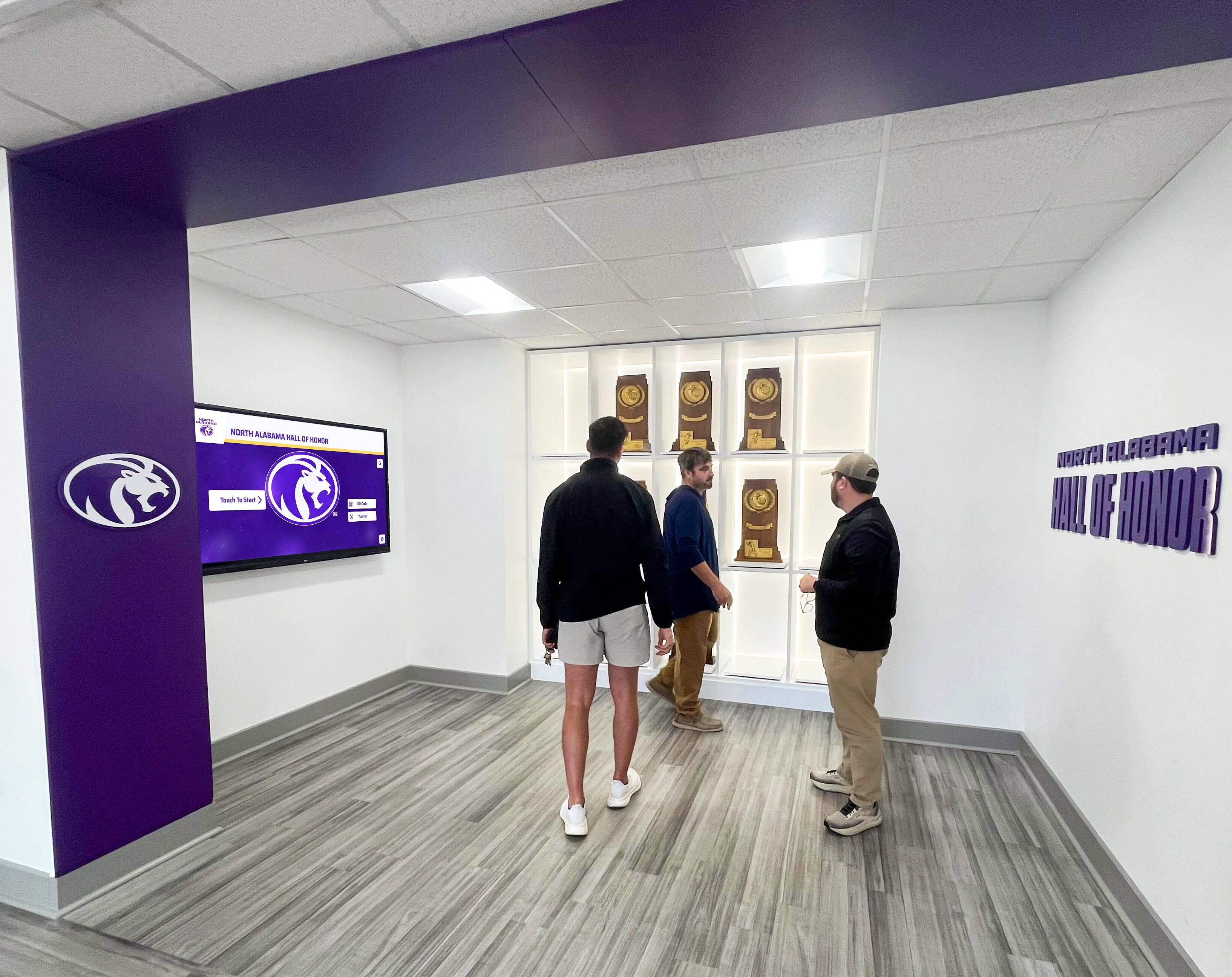
Traditional vs. Modern Alumni Recognition Approaches
Understanding available recognition approaches helps institutions select solutions aligned with their needs, values, and resources.
Traditional Physical Recognition Methods
Classic recognition formats maintain enduring appeal through tangible presence and timeless aesthetics:
Engraved Plaques and Wall Displays:
Traditional engraved recognition remains popular for institutions valuing permanence and classic presentation:
Advantages:
- Timeless, prestigious appearance conveying honor and permanence
- No technical requirements or digital maintenance needs
- Tangible recognition honorees can photograph and share
- Familiar format with broad understanding and acceptance
- Relatively straightforward initial implementation
Limitations:
- Fixed physical space constraints requiring difficult choices as recognition grows
- High ongoing costs for adding inductees ($250-$500 per plaque depending on materials)
- Minimal information capacity beyond names, years, and brief achievement descriptions
- Difficult and expensive to correct errors or update information
- Regular maintenance required for cleaning, polishing, and preservation
Trophy Cases and Display Cabinets:
Physical cases showcase awards, memorabilia, and three-dimensional recognition elements:
Advantages:
- Accommodate meaningful artifacts, trophies, and memorabilia creating emotional connections
- Protected environments for valuable or historically significant items
- Museum-quality presentations elevating perceived importance
- Can include extensive biographical information alongside physical items
Limitations:
- Significant floor or wall space requirements limiting feasibility in space-constrained environments
- Regular maintenance and cleaning needed to maintain professional appearance
- Security concerns for valuable items requiring monitored locations
- Storage challenges as collections grow over time
- Risk of appearing dated without regular refreshment
Programs exploring these traditional approaches benefit from understanding best practices for trophy displays and their role in comprehensive recognition strategies.
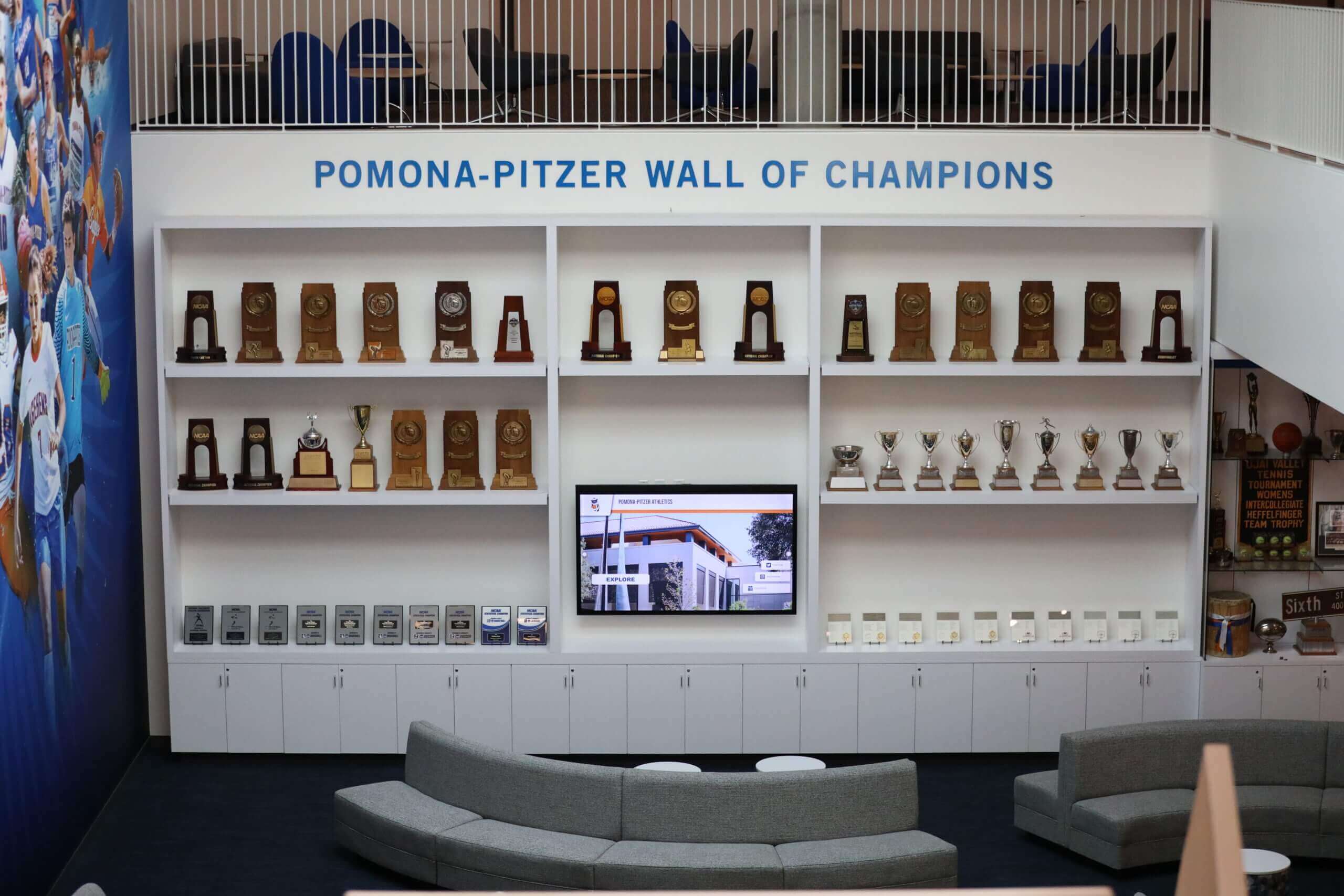
Modern Digital Recognition Solutions
Digital technology has transformed what’s possible for alumni recognition programs, addressing virtually every limitation of traditional systems while introducing powerful new capabilities:
Interactive Digital Recognition Displays:
Touchscreen systems enable rich, engaging recognition experiences impossible with static displays:
Key Capabilities:
- Unlimited Capacity: Recognize hundreds or thousands of alumni without physical space constraints
- Multimedia Storytelling: Comprehensive profiles featuring photos, videos, audio interviews, biographical content, and achievement timelines
- Powerful Search Functionality: Quick access to specific alumni by name, year, achievement category, keyword, or career field
- Easy Content Updates: Add new inductees or modify existing content in minutes through user-friendly content management systems
- Analytics and Insights: Data showing which content resonates, how long visitors engage, and what information they explore
- Remote Access: Web integration allowing alumni worldwide to view recognition from any device
- Social Sharing: Enable viewers to share recognition content via social media, email, or text
- Cost Efficiency: Lower long-term costs compared to repeatedly updating physical displays
Solutions like interactive digital displays combine these capabilities in comprehensive systems designed specifically for educational institutions and organizations implementing recognition programs.
Web-Based Recognition Platforms:
Online recognition portals extend reach beyond physical campus locations:
- Searchable databases featuring all recognized alumni with detailed profiles
- Virtual recognition ceremonies accessible to global audiences
- Alumni networking capabilities connecting honorees with students and each other
- Regular content updates and alumni spotlights maintaining engagement
- Integration with existing institutional websites and alumni portals
- Mobile-responsive design ensuring accessibility across devices
Hybrid Recognition Approaches:
Many leading institutions combine traditional and digital elements, leveraging strengths of each:
- Physical engraved plaques paired with digital kiosks providing extended content
- Trophy cases supplemented with touchscreen displays offering searchable information
- Traditional ceremonies enhanced with video presentations and digital storytelling
- Physical recognition displays promoting web-based platforms for deeper exploration
Understanding options for creating comprehensive digital recognition systems helps institutions select approaches matching their specific needs and contexts.
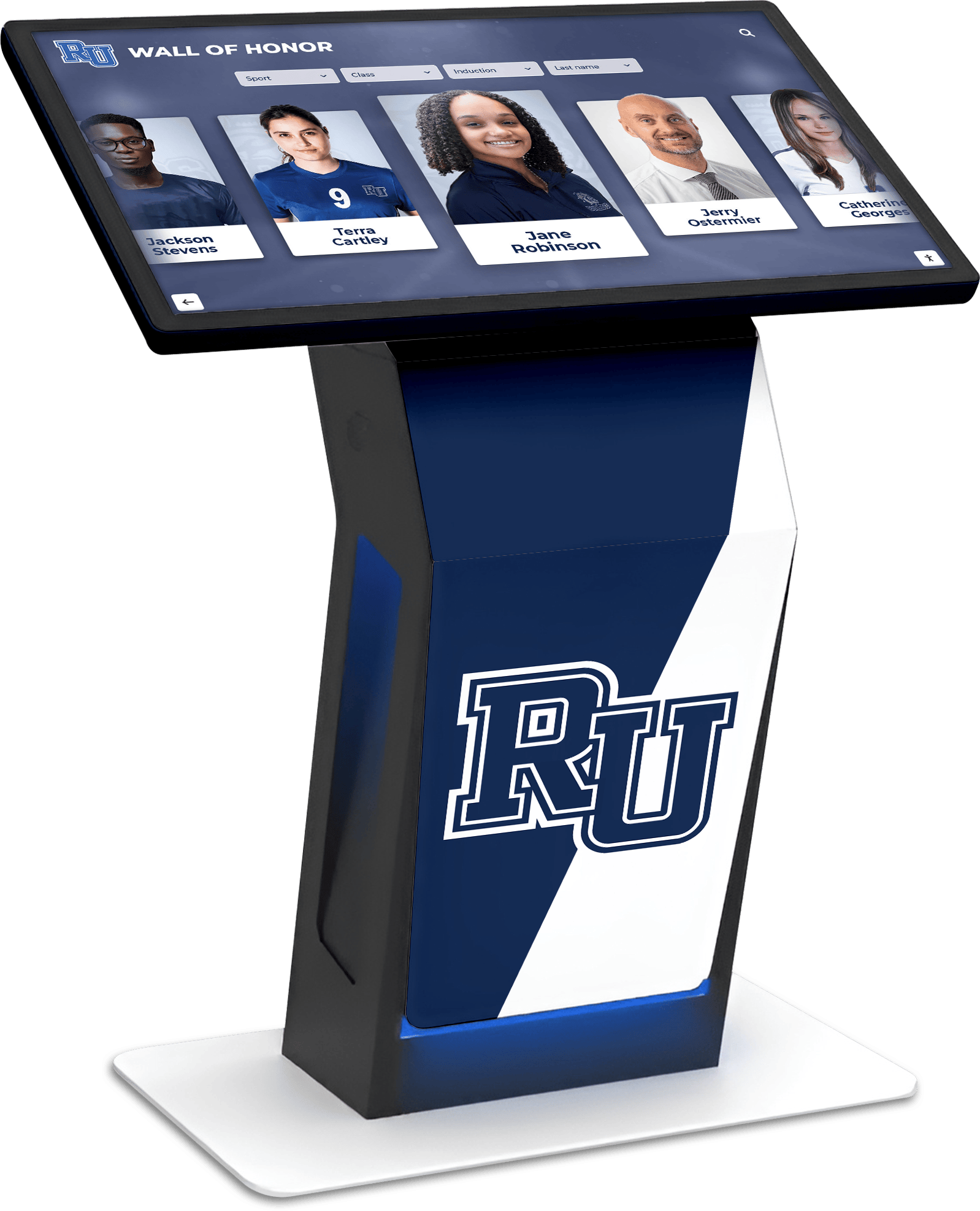
Implementing Your Alumni Recognition Program
Successful alumni recognition programs follow systematic implementation approaches ensuring quality results on time and within budget.
Planning and Assessment Phase
Thorough planning prevents costly mistakes while ensuring solutions match actual institutional needs:
Stakeholder Engagement:
Successful programs begin with comprehensive stakeholder input:
- Survey students, faculty, staff, and alumni about recognition preferences and priorities
- Understand existing recognition traditions and what community members value
- Identify program champions who can advocate for and support enhancement efforts
- Address concerns and build coalition supporting recognition program investment
- Involve diverse voices ensuring recognition criteria reflect varied perspectives
Needs Assessment:
Systematic assessment clarifies requirements:
- Document current recognition approaches and identify limitations or gaps
- Define specific objectives and what success looks like for your program
- Understand physical space options and constraints affecting display possibilities
- Assess technical infrastructure including power, network connectivity, and support capabilities
- Review procurement processes, budget cycles, and decision-making authorities
- Identify potential funding sources including advancement funds, alumni donations, or capital budgets
Program Design:
Clear program design establishes foundation for success:
- Define recognition categories and selection criteria
- Establish nomination and selection processes
- Determine induction frequency (annual, biennial, or rolling)
- Plan recognition events and ceremonies
- Select display approaches (traditional, digital, or hybrid)
- Create communication and marketing strategies
- Establish content development and maintenance workflows
Budget Planning and Resource Allocation
Understanding total cost of ownership enables informed decision-making:
Alumni Recognition Investment Considerations
Traditional Display Investment
- Engraved plaques: $75-$300 per inductee
- Custom display walls: $3,000-$15,000 installation
- Trophy cases: $3,000-$15,000 depending on size
- Annual additions: $500-$2,000 for new plaques
- Maintenance: Periodic cleaning and restoration
Digital Display Investment
- Hardware: $3,000-$12,000 for commercial-grade displays
- Software: $2,000-$6,000 setup + $1,500-$4,000 annual
- Installation: $500-$2,500 professional setup
- Content development: $3,000-$8,000 initial profiles
- Updates: Minimal cost beyond staff time
Return on Investment Considerations:
ROI extends beyond direct cost savings:
- Reduced per-inductee costs at scale over time
- Eliminated ongoing fabrication and installation expenses
- Enhanced institutional reputation and modern image
- Increased alumni engagement driving participation and giving
- Improved recruitment showing prospective students institutional pride
- Better storytelling capabilities supporting advancement efforts
Resources on staff recognition programs provide additional budget planning insights applicable to alumni initiatives.
Content Development and Profile Creation
Compelling content transforms recognition from lists of names into engaging storytelling:
Comprehensive Alumni Profiles Should Include:
- Biographical Information: Educational background, graduation year, areas of study, campus involvement during student years
- Career Trajectory: Professional path, major accomplishments, leadership positions, industry recognition
- Achievement Context: Explanation of significance, broader impact, innovations contributed, or fields influenced
- Personal Stories: Memorable moments, transformative experiences, challenges overcome, advice for current students
- Connection Points: Mentors who influenced them, institutional experiences shaping their paths, ongoing institutional involvement
- Multimedia Elements: Professional photos, video interviews, news articles, audio reflections, achievement documentation
Gathering Quality Content:
Systematic content collection ensures rich profiles:
- Detailed nomination forms requesting comprehensive information from nominators
- Questionnaires sent to inductees gathering direct input about their experiences and accomplishments
- Interviews with honorees creating video content and capturing authentic voices
- Research identifying news coverage, publications, awards, and external recognition
- Photo collection including current professional images and historical campus photos
- Coordination with institutional archives accessing historical information and documentation
Effective content strategies for digital recognition ensure displays remain engaging and relevant over time.
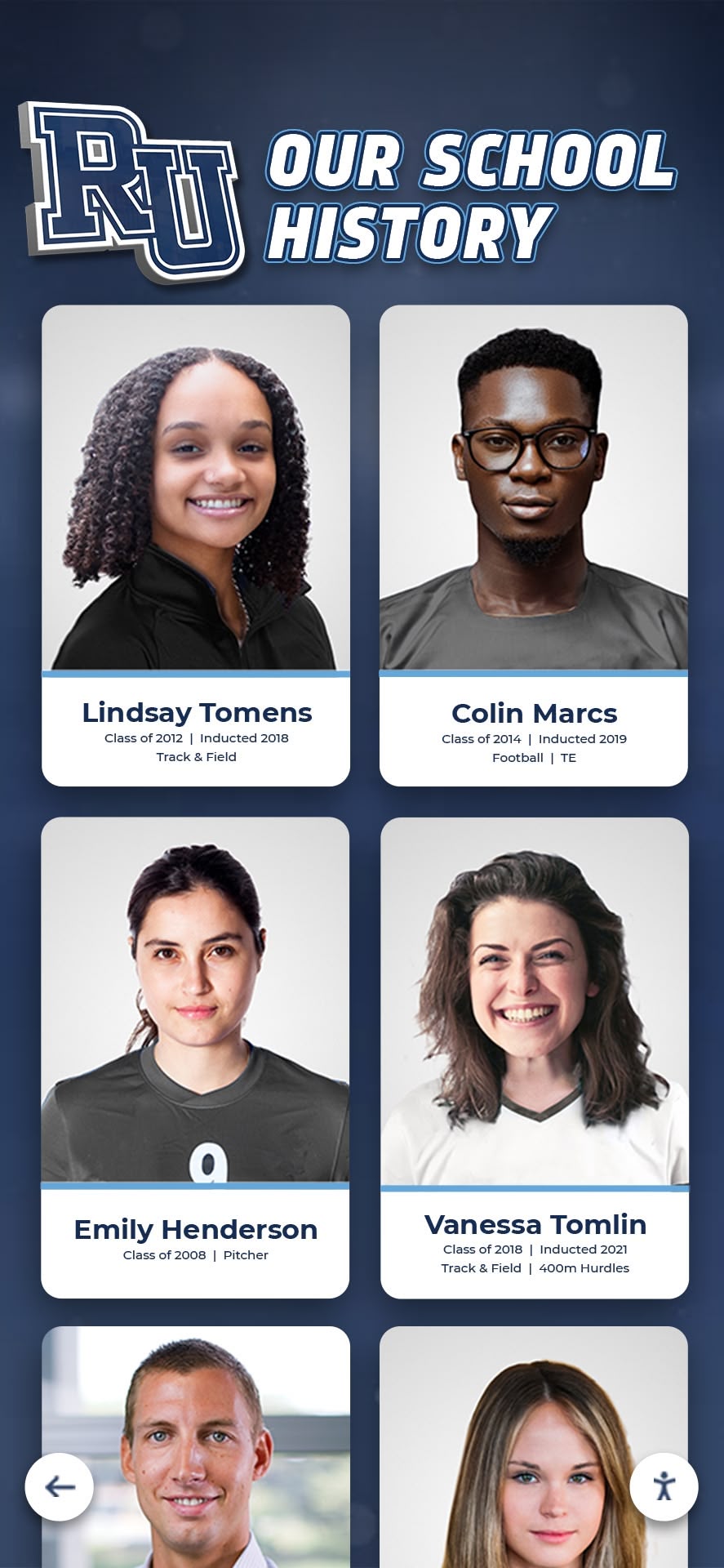
Maximizing Program Impact Through Strategic Communication
Even exceptional alumni recognition programs achieve limited impact without strategic communication ensuring visibility and awareness.
Multi-Channel Communication Strategies
Comprehensive communication reaches diverse audiences through preferred channels:
Digital Communication Channels:
- Institutional Websites: Dedicated recognition program pages with searchable databases, nomination information, and ceremony details
- Email Marketing: Targeted messages to alumni, donors, students, and community members highlighting inductees and program news
- Social Media: Regular spotlights on individual honorees, behind-the-scenes content, ceremony announcements, and engagement opportunities
- Alumni Newsletters: Featured recognition stories, calls for nominations, and program updates in existing communications
- Student Publications: Recognition program features in student newspapers, magazines, and digital platforms
Traditional Communication Channels:
- Print Publications: Alumni magazines, annual reports, and institutional publications featuring recognition stories
- Campus Signage: Posters and displays promoting nomination periods, ceremonies, and new inductees
- Event Programs: Recognition content in graduation programs, athletics events, and campus gatherings
- Media Relations: Press releases to local and national media highlighting distinguished alumni achievements
- Direct Mail: Formal ceremony invitations and recognition announcements to key stakeholders
In-Person Communication:
- Campus Displays: Prominent physical or digital displays showcasing recognized alumni in high-traffic locations
- Classroom Integration: Faculty incorporating alumni stories into curriculum as relevant examples
- Admissions Tours: Recognition displays featured in prospective student tours demonstrating institutional pride
- Development Meetings: Recognition program highlights in donor cultivation and stewardship conversations
Leveraging Recognition for Advancement
Strategic alumni recognition programs support broader institutional advancement goals:
Donor Cultivation and Stewardship:
Recognition creates natural touchpoints for development activities:
- Recognition events provide cultivation opportunities with potential major donors
- Honoring giving as recognition criterion encourages philanthropic engagement
- Recognized alumni often become donors themselves following acknowledgment
- Recognition displays demonstrate appreciation for donor support
- Alumni stories illustrate impact of contributions on student outcomes
Alumni Engagement Enhancement:
Recognition drives broader participation across alumni population:
- Recognition ceremonies create compelling reunion activities
- Honorees often increase their own institutional involvement following recognition
- Recognition visibility reminds broader alumni of their institutional connections
- Nomination processes engage alumni in identifying distinguished peers
- Recognition content provides shareable material alumni proudly distribute
Programs understanding how to connect with alumni effectively integrate recognition into comprehensive engagement strategies.
Measuring Program Success
Data-driven assessment enables continuous program improvement:
Quantitative Metrics:
- Nomination volume and diversity across achievement categories
- Ceremony attendance trends and participant satisfaction scores
- Digital display engagement metrics (views, searches, time spent)
- Web platform traffic and profile page views
- Social media reach, engagement, and sharing activity
- Alumni giving rates among recognized vs. non-recognized populations
- Student survey responses about inspiration and institutional pride
Qualitative Indicators:
- Testimonials from inductees about recognition meaning and impact
- Feedback from students about how recognition influenced their perspectives
- Stakeholder commentary about program value and suggestions for enhancement
- Media coverage quality and institutional reputation enhancement
- Anecdotal evidence of increased alumni engagement following recognition
- Staff and faculty observations about cultural impact
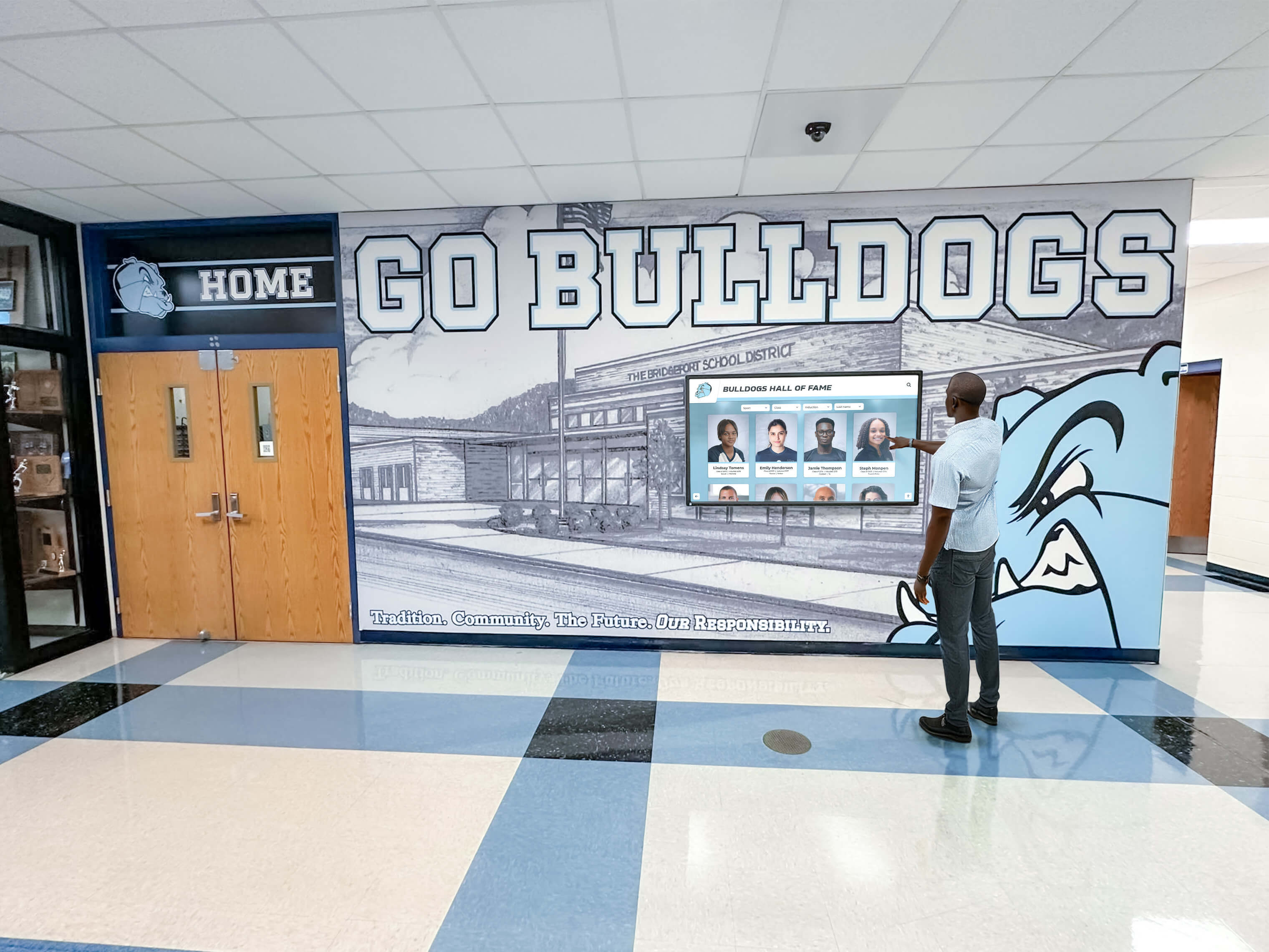
Best Practices for Long-Term Program Success
Sustainable alumni recognition programs require ongoing attention, continuous improvement, and strategic evolution.
Regular Program Maintenance and Updates
Consistent maintenance ensures recognition remains current and compelling:
For Physical Displays:
- Weekly dusting and cleaning maintaining professional appearance
- Quarterly inspection for damage, loose mountings, or needed repairs
- Annual professional cleaning and polishing of metal elements
- Prompt replacement or repair of damaged components
- Periodic design refreshes keeping displays visually current
For Digital Systems:
- Immediate addition of new inductees upon selection
- Regular content enhancements adding photos, videos, or updated information
- Quarterly software updates and security patches
- Seasonal themes and featured content rotation maintaining freshness
- Analytics review identifying popular content and improvement opportunities
- Technical support coordination addressing any system issues promptly
Understanding approaches to maintaining digital recognition displays ensures long-term reliability and effectiveness.
Continuous Program Enhancement
Leading programs regularly evolve based on assessment and emerging best practices:
Content Expansion:
- Adding distinguished alumni from earlier eras creating comprehensive historical recognition
- Developing video interview libraries capturing inductee voices and wisdom
- Creating thematic collections highlighting specific fields, eras, or achievement types
- Integrating student perspectives about how alumni inspire them
- Adding career pathway information helping students understand diverse possibilities
Program Integration:
- Incorporating recognition content into curriculum and classroom lessons
- Using alumni paths as career exploration resources for students
- Inviting inductees for speaking engagements, mentorship programs, or class visits
- Connecting recognition to fundraising campaigns and advancement priorities
- Extending visibility through all institutional communication channels
- Coordinating with high school reunion planning and other alumni events
Process Refinement:
- Regularly reviewing selection criteria ensuring continued relevance
- Expanding recognition categories to capture emerging achievement types
- Enhancing nomination processes making participation easier and more inclusive
- Improving ceremony experiences based on participant feedback
- Strengthening communication strategies reaching broader audiences
- Benchmarking against peer institutions and adopting proven innovations
Building Program Sustainability
Ensuring long-term viability requires attention to sustainability factors:
Leadership and Ownership:
- Clear program ownership with designated staff responsibility
- Succession planning ensuring continuity through leadership transitions
- Committee structures distributing work and building broad investment
- Student involvement creating ongoing connection and relevance
Resource Allocation:
- Dedicated annual budgets supporting ongoing program operations
- Staffing allocations providing adequate time for quality program management
- Technical support ensuring digital systems remain functional and current
- Content development resources creating compelling inductee profiles
Institutional Integration:
- Recognition program embedded in institutional strategic plans
- Alignment with advancement, enrollment, and student success priorities
- Cross-functional collaboration leveraging marketing, communications, and development resources
- Board and leadership visibility reinforcing program importance
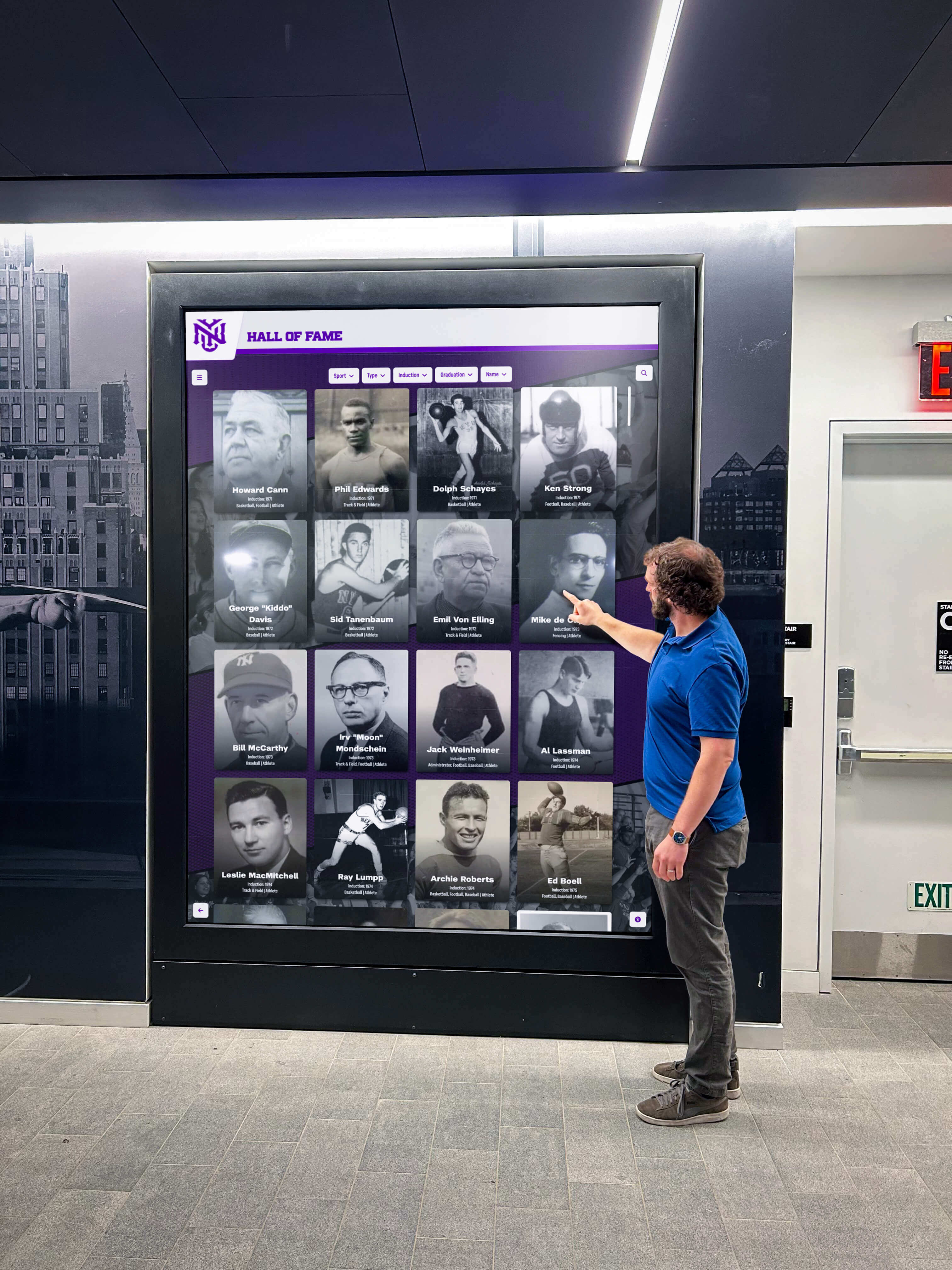
Choosing the Right Recognition Solution
The “best” alumni recognition program depends on your specific circumstances, institutional culture, and available resources.
Key Decision Factors:
Choose Traditional Physical Recognition If:
- Strong institutional preference for classic, timeless aesthetics
- Limited technical support capabilities or concerns about digital reliability
- Small, stable recognition program with manageable scale
- Existing traditional systems working well and requiring expansion
- Budget priorities favor lower upfront investment
Choose Digital Interactive Recognition If:
- Growing program requiring unlimited scalability over time
- Priority on comprehensive multimedia storytelling capabilities
- Desire to maximize engagement through interactive features
- Long-term cost efficiency more important than initial investment
- Technical support available through vendors or internal resources
- Interest in analytics showing program impact and engagement
Choose Hybrid Approaches If:
- Want to honor tradition while embracing modern capabilities
- Multiple recognition tiers requiring different presentation methods
- Transitioning from traditional to digital gradually over time
- Space and budget allow for complementary systems
- Stakeholder concerns require preserving valued traditional elements
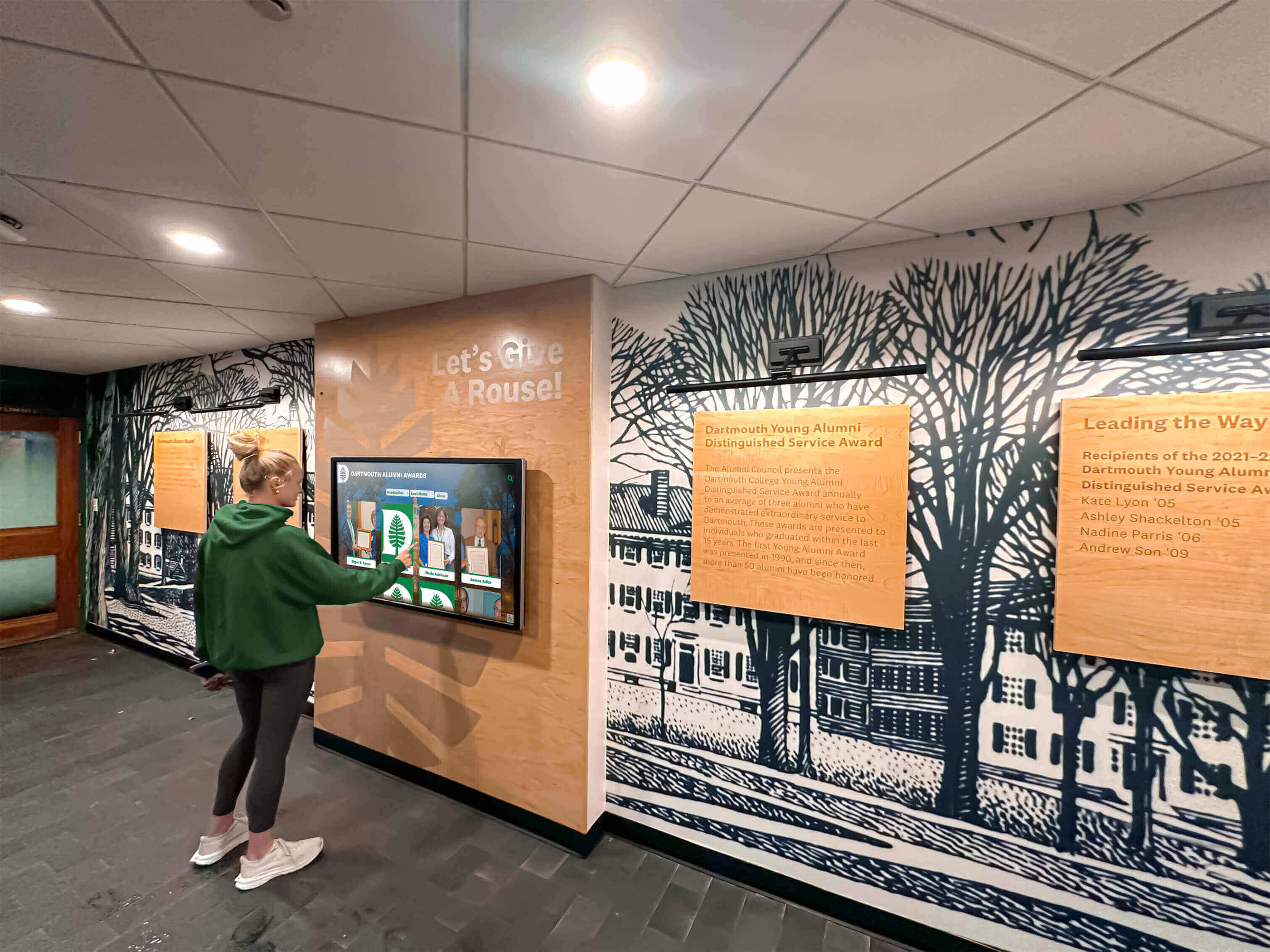
Regardless of format, the most important factors remain:
- Clear Purpose: Understanding why recognition matters and what you hope to achieve
- Quality Content: Investing in rich, meaningful profiles telling complete stories
- Strategic Visibility: Placing recognition where it will be seen and engaged with regularly
- Fair Processes: Maintaining transparent, credible selection criteria and procedures
- Sustainable Management: Establishing systems ensuring programs remain current and compelling
- Continuous Improvement: Regularly assessing effectiveness and evolving based on feedback
Conclusion: Creating Lasting Impact Through Recognition
Alumni recognition programs represent far more than ceremonial acknowledgments or decorated wall space—they embody institutional values, honor distinguished graduates exemplifying those values, and inspire current students to pursue excellence in their own unique ways.
The most successful programs share common characteristics: clear criteria, compelling content, strategic communication, meaningful events, appropriate display solutions, and genuine integration into institutional life. When these elements align, alumni recognition programs become cherished traditions that strengthen connections, build community pride, and inspire achievement for generations.
As you develop or enhance your institution’s alumni recognition program, remember that you’re not just acknowledging past achievements—you’re creating inspiration for future excellence, building bridges between generations, and establishing traditions that will honor distinction and strengthen institutional bonds for decades to come.
Ready to Transform Your Alumni Recognition Program?
Explore how modern solutions can elevate your recognition initiatives. Learn about comprehensive recognition networks that showcase achievements while building community pride, or discover strategies for engaging alumni effectively through digital innovation.
For personalized guidance on creating an impactful alumni recognition program tailored to your specific needs, consider how digital recognition solutions can help you celebrate excellence, inspire students, and strengthen the lasting bonds that make your institutional community thrive across generations.
